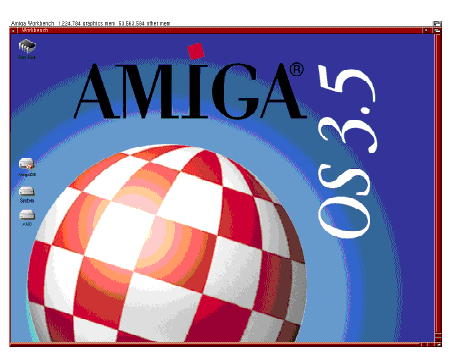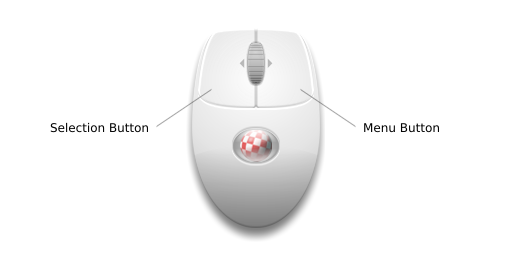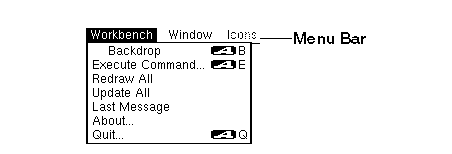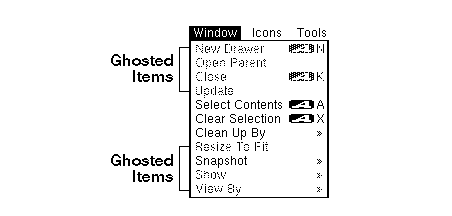Copyright (c) Hyperion Entertainment and contributors.
AmigaOS Manual: Workbench Basic Operations
Before using your Amiga, you should familiarize yourself with the basic Amiga system concepts and techniques provided in this chapter. These include:
- Booting your system
- Using the pointers
- Using the mouse
- Handling disks and using disk drives
- Creating and accessing files and directories
Contents
Booting/Rebooting Your System
Booting powers on your computer and loads the operating system information from a disk to the computer's memory. Each time the Amiga is booted, the system must find the Amiga system software on a bootable hard disk or floppy disk inserted into a disk drive. If there are no bootable disks when the system is powered on, an animated screen requests that you insert a bootable disk into a floppy drive.
Rebooting resets you computer without turning off the power. This process terminates any active programs and erases any data stored in the Amiga's memory.
For information about booting and rebooting floppy-only systems, see Appendix B.
Each time the Amiga is booted or rebooted, the following events occur:
1. The Amiga executes a script file called the Startup-sequence. The Startup-sequence file contains AmigaDOS commands that load the Amiga software and handle various hardware and software setup tasks.
2. The Startup-sequence executes a script file called User-startup, if you have created it. In general, User-startup files contain your own customized configurations, resident commands, and directory assignments. Appendix B offer some instructions and suggestions of items that you can place in a User-startup file.
3. The Amiga Workbench screen appears, as illustrated in Figure 2-1.
4. Workbench runs any programs whose icons are in the WBStartup drawer. By placing program icons in the WBStartup drawer, you can also customize your system startup.
Do not alter the Startup-sequence file, doing so can prevent the Amiga from booting properly.
To reboot your system:
- Be sure that all disk activity has stopped and that all floppy disk drive and hard disk drive lights are unlit.
- If you are rebooting from a floppy disk drive, insert a copy of the Workbench disk into a floppy disk drive.
- Simultaneously hold down the Ctrl (Control), left Amiga, and right Amiga keys and then release them.
Special Boot Options
Extra memory used for maintaining devices can prevent floppy-based games from running. See Appendix D for information about how to avoid this problem.
Using the Workbench Pointers
The Workbench has two pointers: the mouse pointer and the busy pointer.
Mouse Pointer
The mouse pointer is a small movable picture that is used to indicate to te system the location at which you wish to do some operation. By default the mouse pointer is an image of an arrow. The mouse pointer is moved and positioned with the mouse. The tip of the pointer has a hot spot, which is one pixel (a dot of light that makes up the monitor screen display) that the system is programmed to recognize a the pointer's locator. The pointer indicates to the system the position of an item that you wish to work with. Through the mouse, you communicate the action that the system should take on this item. You can change the shape and color of the mouse pointer using the Pointer Preferences editor, described in Chapter 5.
Busy Pointer
The busy pointer, also referred to as the wait pointer, is displayed in place of the mouse pointer to indicate that the system is attempting to execute an instruction. By default the busy pointer is an image of a stopwatch. Most Workbench operations are unavailable while the busy pointer is displayed. However, you can still move, size, and depth-arrange windows with the busy pointer. The appearance of this pointer can also be changed using the Pointer Preferences editor described in Chapter 5.
Using the Mouse
The Amiga comes equipped with a mouse, illustrated in Figure 2-2, used to communicate with the system through the pointer. The mouse pointer is positioned by moving the mouse. Manipulating the mouse so that the pointer is located over various objects and pictures on the screen and pressing the mouse buttons tells the Amiga what to do.
Holding the Mouse
Hold the mouse on a flat surface with the cable extending away from you so that the mouse box rests under the palm of your hand with the buttons under your fingertips. In this position, the left mouse button is the selection button and the right mouse button is the menu button.
Mouse Operations
When using the mouse,
| Pointing | means moving the mouse so that the tip of the pointer is positioned over an object on the screen. The pointer moves in the same direction you move the mouse. The mouse can be lifted and repositioned at any time. Lifting the mouse does not move the pointer. |
| Clicking | means pressing and releasing the selection button. |
| Double-Clicking | means clicking the selection button twice in rapid succession. Double-clicking on an icon causes a window to appear or a program to start. |
| Holding Down | means pressing the mouse button until your action is completed. |
| Dragging | means moving screens, windows, and icons by holding down the selection button and moving the mouse. |
Using the Selection Button
The left mouse button is the selection button, used for selecting items on the monitor display for processing. This button is also used to move, or drag, items on the screen. For information about these operations, see Chapter 3.
Using the Menu Button
The right mouse button is the menu button, which is used to display the menu bar and menus and to choose items from them. Menu bars contain the headings of each menu available for a selected window, program, or icon. Menus contain lists of options for the operations that you can do with the selected item.
Using Menus
Menu bars appear across the top of the screen, containing any menu headings available.
Hold down the menu button to display the menu bar as illustrated in Figure 2-3. Hol down the menu button while pointing to the different menu headings to show the available items listed beneath each. To choose a particular item, move the pointer down and release the menu button when the pointer touches it.
Some menu items have submenus, which are additional related options that appear to the right of the menu item when it is selected. The symbol » after the item name indicates a submenu. If a menu has submenus, select one of the submenu options. Choosing a main menu item without choosing one of its submenus has no effect. In addition to the » symbol, other symbols may appear on the menu:
- An ellipsis (...) follows the name of menu items that open a requester.
- A checkmark in the area to the left of a menu item indicates that the items is an option that is currently selected. When this area is empty, the option is deselected.
To execute several menu options at once, hold down the menu button and, using the selection button, click on the menu options of your choice.
The menu button can also be used to cancel operations being performed by the selection button, such as drag selection.
Ghosted Menu Items
If a menu item is not available for a particular operation, it is ghosted or displayed less distinctly than the others, as illustrated in Figure 2-4.
Canceling an Operation
Cancel the operation being performed with the selection button by clicking the menu button while still holding down the selection button. The following operations can be cancelled:
- Selecting
- Dragging
- Drag selection
- Changing the size of a window
Using the Amiga Without a Mouse
All mouse actions can also be done using the keyboard. Certain key combinations allow use of the keyboard to move the pointer, select icons, and choose menu items. Keyboard shortcuts appear in the menu boxes to the right of some options. Holding down the right Amiga key and simultaneously pressing the letter displayed attains the same results as activating that menu option. Using the keyboard shortcuts instead of the menus speeds your work. For a full description of key functions, see the hardware manual for your Amiga model.
Using Disk Drives
To Be Continued...



